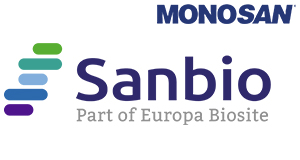Anti-hnRNP D/AUF1/HNRNPD Antibody Picoband™ (monoclonal, 2B12)
Anti-hnRNP D/AUF1/HNRNPD Antibody Picoband™ (monoclonal, 2B12)
Artikelnummer
SANMON23735
Verpackungseinheit
100μg
Hersteller
Sanbio / Monosan
Verfügbarkeit:
wird geladen...
Preis wird geladen...
Clone Number: 2B12
Immunogen: E.coli-derived human hnRNP D/AUF1/HNRNPD recombinant protein (Position: E88-N246).
Concentration: Adding 0.2 ml of distilled water =f 500 μg/ml.
Format: Lyophilized
Storage buffer: Each vial contains 4mg Trehalose, 0.9mg NaCl, 0.2mg Na2HPO4, 0.05mg NaN3.
Additional info: Store at -20˚C for one year from date of receipt. After reconstitution, at 4˚C for one month. It can also be aliquotted and stored frozen at -20˚C for six months. Avoid repeated freeze-thaw cycles.Add 0.2ml of distilled water will yield a concentration of 500ug/ml. Background: Heterogeneous nuclear ribonucleoprotein D0 (HNRNPD) also known as AU-rich element RNA-binding protein 1 (AUF1) is a protein that in humans is encoded by the HNRNPD gene. It is mapped to 4q21.22. This gene belongs to the subfamily of ubiquitously expressed heterogeneous nuclear ribonucleoproteins (hnRNPs). The hnRNPs are nucleic acid binding proteins and they complex with heterogeneous nuclear RNA (hnRNA). These proteins are associated with pre-mRNAs in the nucleus and appear to influence pre-mRNA processing and other aspects of mRNA metabolism and transport. While all of the hnRNPs are present in the nucleus, some seem to shuttle between the nucleus and the cytoplasm. The hnRNP proteins have distinct nucleic acid binding properties. The protein encoded by this gene has two repeats of quasi-RRM domains that bind to RNAs. It localizes to both the nucleus and the cytoplasm. This protein is implicated in the regulation of mRNA stability. Alternative splicing of this gene results in four transcript variants. Subcellular Localization: Tissue Specificity:
Immunogen: E.coli-derived human hnRNP D/AUF1/HNRNPD recombinant protein (Position: E88-N246).
Concentration: Adding 0.2 ml of distilled water =f 500 μg/ml.
Format: Lyophilized
Storage buffer: Each vial contains 4mg Trehalose, 0.9mg NaCl, 0.2mg Na2HPO4, 0.05mg NaN3.
Additional info: Store at -20˚C for one year from date of receipt. After reconstitution, at 4˚C for one month. It can also be aliquotted and stored frozen at -20˚C for six months. Avoid repeated freeze-thaw cycles.Add 0.2ml of distilled water will yield a concentration of 500ug/ml. Background: Heterogeneous nuclear ribonucleoprotein D0 (HNRNPD) also known as AU-rich element RNA-binding protein 1 (AUF1) is a protein that in humans is encoded by the HNRNPD gene. It is mapped to 4q21.22. This gene belongs to the subfamily of ubiquitously expressed heterogeneous nuclear ribonucleoproteins (hnRNPs). The hnRNPs are nucleic acid binding proteins and they complex with heterogeneous nuclear RNA (hnRNA). These proteins are associated with pre-mRNAs in the nucleus and appear to influence pre-mRNA processing and other aspects of mRNA metabolism and transport. While all of the hnRNPs are present in the nucleus, some seem to shuttle between the nucleus and the cytoplasm. The hnRNP proteins have distinct nucleic acid binding properties. The protein encoded by this gene has two repeats of quasi-RRM domains that bind to RNAs. It localizes to both the nucleus and the cytoplasm. This protein is implicated in the regulation of mRNA stability. Alternative splicing of this gene results in four transcript variants. Subcellular Localization: Tissue Specificity:
| Artikelnummer | SANMON23735 |
|---|---|
| Hersteller | Sanbio / Monosan |
| Hersteller Artikelnummer | MON23735 |
| Verpackungseinheit | 100μg |
| Mengeneinheit | STK |
| Reaktivität | Human, Mouse (Murine), Rat (Rattus) |
| Klonalität | Monoclonal |
| Methode | Immunofluorescence, Western Blotting, Flow Cytometry, Immunohistochemistry, Immunocytochemistry |
| Isotyp | IgG2a |
| Wirt | Mouse |
| Konjugat | Unconjugated |
| Produktinformation (PDF) |
|
| MSDS (PDF) |
|

 English
English







